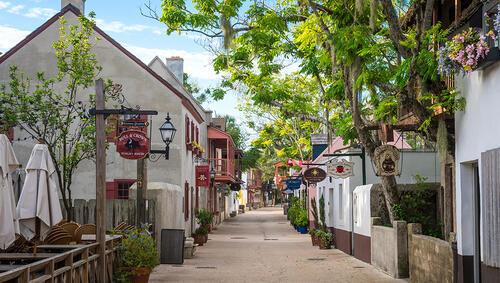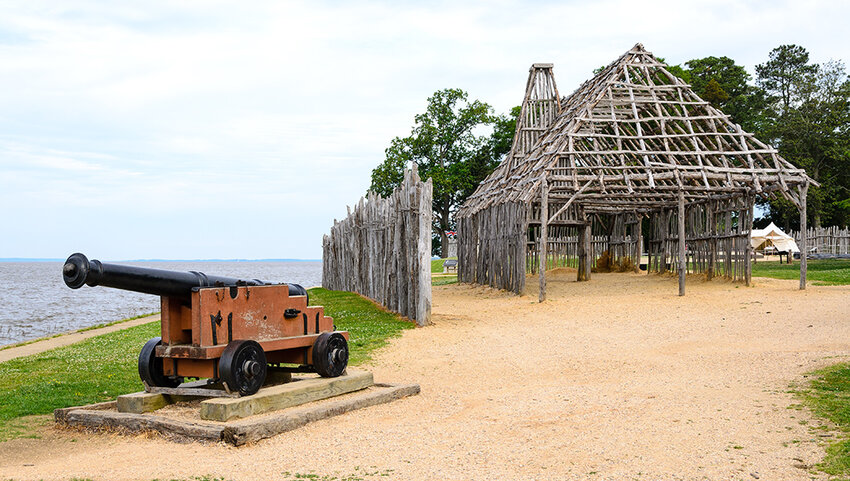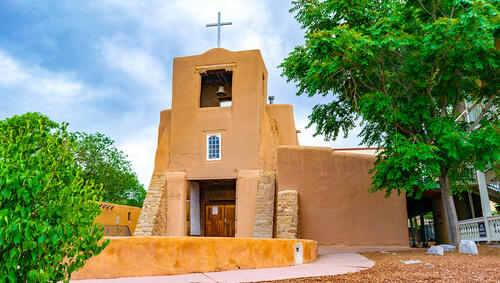Coming up with a definitive list of the oldest cities in the U.S. isn’t as straightforward as it seems. For instance, should somewhere be continuously settled, or would you include a place where people left for a time and later returned? Would a name change disqualify a settlement or is that simply part of its history? Is a certain level of population a prerequisite for a place to be classed as a city? What follows is one version of a list that could take myriad forms depending on your own definitions. Here are the stories of five of the oldest cities in the U.S.
Old Oraibi, Arizona and the Pueblos of New Mexico

Old Oraibi in Arizona is a Hopi pueblo that is probably the oldest continually occupied settlement in the U.S., dating from about 1150 CE, though its size means it’s more likely to be considered a village than a city. The oldest of New Mexico’s Pueblos is Acoma Sky City, founded around 1150 CE, though as with Old Oraibi in Arizona, few people live there today. In contrast, Taos Pueblo is now home to around 150 permanent residents. According to the NPS, the original Pueblo site dates back to 1325 CE; referred to now as the “Cornfield Taos” it sits just east of today’s settlement.
The adjacent town of Taos also has a long history. The Spanish conquistadors, led by Hernando de Alvarado, came here in 1540. The goal of their expedition was to find the seven cities of Cibola, a mythical province that was believed to be the source of great wealth. But, instead of gold, they found homes made of adobe. Nevertheless, in 1615, Don Fernando de Taos founded a settlement. There was soon resentment between the incomers and the indigenous Tewa people, culminating in a succession of revolts, expulsions and resettlements until the Spaniards finally asserted control in 1696.
St Augustine, Florida

St Augustine is the oldest continuously occupied settlement of European and African-American origin in the U.S. It can trace its history back to 1565, when Don Pedro Menéndez de Avilés founded the city. The year before, French Huguenots had settled near the mouth of the St. Johns River at what’s now Jacksonville, but the Spanish were determined that Florida should be theirs and asserted their claim. After years of skirmishes, it would all go horribly wrong for the Spanish when Florida and St Augustine were awarded to the British under the Treaty of Paris in 1763.
Those 16th-century buildings in St Augustine weren’t constructed to last, so today, the oldest structure you’ll see is the Castillo de San Marcos. It was built in the late 17th century by the Spanish out of coquina, a type of limestone formed from seashells. The street pattern of downtown St Augustine is also unmistakably Spanish, boasting 36 buildings of colonial origin which were renovated for the city’s 400th anniversary. Today’s visitors can take a walking tour through the Colonial Quarter, where costumed hosts re-enact the past with live musket firing, blacksmithing demonstrations and other activities.
Jamestown, Virginia

Jamestown, Virginia was founded in 1607 as the site of the first English settlement in North America. The settlement was far enough inland to be defended from possible attacks from the Spanish, yet with water on three sides it allowed ships to dock and unload passengers and cargo without difficulty. A fort was quickly erected to ensure residents’ safety during any skirmishes with the local Powhatan Indians. However, this early settlement was largely abandoned after a fire in 1699, though the area was still farmed. It was later reimagined as a visitor attraction, but there’s still a private residence on the island.
Jamestown isn’t the only part of Virginia that can trace such history back more than 400 years. For example, Bermuda Hundred (sometimes referred to as Bermuda Cittie or City) was established by an English naval commander called Sir Thomas Dale in 1613. Within three years, the population had grown to 119. A town was formally laid out in 1688; official status as one of Virginia’s ports was granted in 1691. By 1732, a ferry ran across the James River between the territory of Bermuda Hundred and City Point, which was eventually swallowed up into Hopewell in 1923.
Santa Fe, New Mexico

The Spanish initially established what would become the oldest state capital in the U.S. in 1607, returning to flesh out a settlement in 1609. They called it Villa Real de la Santa Fe de San Francisco de Asis, but they weren’t the first to live here. Ogha Po’oge (Tewa for White Shell Water Place) was constructed here in 900 CE. The place had long been abandoned by the time conquistador Don Pedro de Peralta arrived the found the ruins. In fact, the Pueblo Indians regained control for just over a decade towards the end of the 17th century, but Don Diego de Vargas reclaimed it for the Spanish in 1692. New Mexico became a U.S. territory in 1850.
These days, Santa Fe’s adobe structures are a big tourist draw. The Palace of the Governors, now a history museum, dominates the main plaza. A few blocks away you’ll find the San Miguel Chapel, the oldest Catholic Church in the country. Opposite is a museum and gift store which bills itself as the city’s oldest house. Though the precise date of construction is undocumented, tree ring samples date some of its vigas (timbers) to between 1740 and 1767. A portion of one interior wall bears evidence of puddled adobe, which historians tell us predates the adobe bricks favored by the Spanish.
Albany, New York

In 1609, the English explorer Henry Hudson set sail from Amsterdam in the Halve Maen, tasked by the Dutch East India Company to find a passage to Asia. During the expedition, he found himself on the river that would one day bear his name. As a result of that voyage, the Dutch established a claim in the area and in 1614, their fur traders established Fort Nassau on Westerlo Island. The climate at the time was cooler than today and beaver fur was in high demand. The Mohawk people were expert trappers and the Europeans saw the value in making alliances for business.
Fort Nassau was prone to flooding, so a decade later, the larger Fort Orange replaced it. Located a mile or so further north, it stands in what’s now the heart of downtown Albany. Within a few decades, the first permanent settlement in New Netherland had grown considerably to become Beverwijck (Beaver District). In 1664, the Dutch surrendered New Netherland to the British. King Charles II gave the territory to his brother James, the Duke of York and Albany and so Beverwijck was renamed Albany. It was officially granted its city charter in 1686 and is now New York’s state capital.





